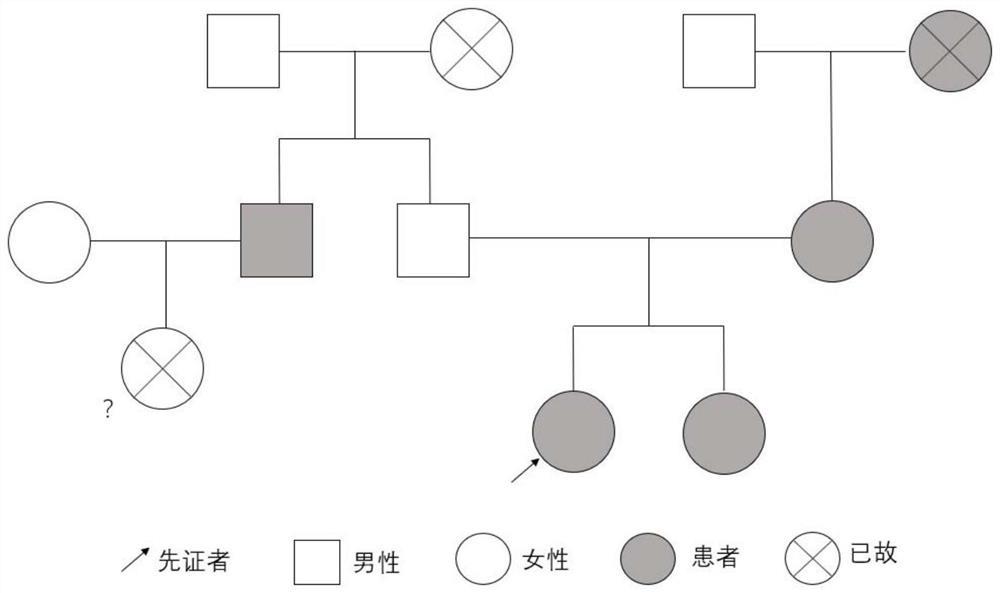New mutated protein, new mutated gene and its application related to long Qt syndrome
A technology for mutant proteins and proteins, applied in the field of human mutant genes, can solve problems such as inability to explain pathogenic genes, and achieve the effect of promoting the research and development of innovative drugs and reducing the number of children born.
- Summary
- Abstract
- Description
- Claims
- Application Information
AI Technical Summary
Problems solved by technology
Method used
Image
Examples
Embodiment 1
[0043] Embodiment 1: long QT syndrome patient / carrier verification experiment
[0044] Sample source: Baoding First Central Hospital, on the premise that the long QT syndrome proband and his family voluntarily signed the informed consent, sent 5-10mL whole blood samples (added with EDTA anticoagulation, stored at -80 ℃), established The medical records database records the proband's condition, family status and other information in detail. This study has been approved by the institutional ethics committee.
[0045] Randomly collected 200 healthy samples unrelated to the long QT syndrome proband family as verification samples, each collected 2-4ml EDTA anticoagulant blood, and stored at -80°C.
[0046] 1. Preparation of Genomic DNA
[0047] Whole-genome DNA was extracted from human whole blood EDTA anticoagulated samples of the proband and verification samples, using the magnetic bead method whole blood genome DNA extraction kit, and the operation steps were carried out accor...
Embodiment 2
[0081] Example 2: Verification experiment of irrelevant samples-family screening of long QT syndrome
[0082] 1. Experimental method
[0083] A family with long QT syndrome was recruited (the family picture is shown in figure 1 shown), all family members (4 patients in the family and 4 normal people in the family) underwent laboratory examination, electrocardiogram and dynamic electrocardiogram examination, exercise electrocardiogram examination and imaging examination, and preliminarily confirmed that they were consistent with long QT syndrome family characteristics.
[0084] Through genetic testing, 4 patients with long QT syndrome were detected in this family; according to family members, a deceased member of this family was also a patient with long QT syndrome.
[0085] In addition, 1453 healthy people without long QT syndrome were recruited as controls.
[0086] The method in Example 1 was used to amplify the KCNH2 gene c.1369 of each member of the family and the cont...
Embodiment 3
[0097] Example 3: KCNH2 gene kit for in vitro detection of patients with long QT syndrome
[0098] 1. Kit composition:
[0099]
[0100] 2. How to use:
[0101] (1) Genomic DNA extraction: Use a DNA extraction kit to extract genomic DNA from peripheral blood samples.
[0102] (2) PCR amplification: PCR amplification was performed using the above-mentioned kit, and the reaction system and reaction conditions were referred to in Example 1.
[0103] (3) Purify the PCR amplification product.
[0104] (4) Perform Sanger sequencing on the purified PCR amplification products.
[0105] (5) Analyze the sequencing results and compare whether there is a heterozygous mutation of c.1369G>A in the KCNH2 gene.
PUM
 Login to View More
Login to View More Abstract
Description
Claims
Application Information
 Login to View More
Login to View More - R&D
- Intellectual Property
- Life Sciences
- Materials
- Tech Scout
- Unparalleled Data Quality
- Higher Quality Content
- 60% Fewer Hallucinations
Browse by: Latest US Patents, China's latest patents, Technical Efficacy Thesaurus, Application Domain, Technology Topic, Popular Technical Reports.
© 2025 PatSnap. All rights reserved.Legal|Privacy policy|Modern Slavery Act Transparency Statement|Sitemap|About US| Contact US: help@patsnap.com



